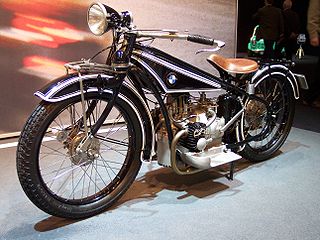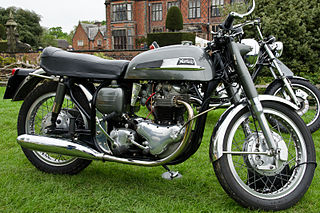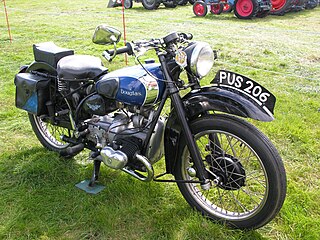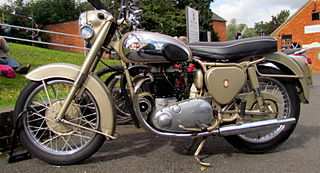
Indian Motorcycle is an American brand of motorcycles originally produced from 1901 to 1953 in Springfield, Massachusetts, United States. Hendee Manufacturing Company initially produced the motorcycles, but the name was changed to the Indian Motorcycle Manufacturing Company in 1923.

A flat-twin engine is a two-cylinder internal combustion engine with the cylinders on opposite sides of the crankshaft. The most common type of flat-twin engine is the boxer-twin engine, where both cylinders move inwards and outwards at the same time.

BMW's motorcycle history began in 1921 when the company commenced manufacturing engines for other companies. BMW's own motorcycles—sold under the BMW Motorrad brand—began in 1923 with the BMW R 32, which was powered by a flat-twin engine. Production of motorcycles with flat-twin engines continues to this day, however BMW has also produced many models with other types of engines.

A. J. Stevens & Co. Ltd was a British automobile and motorcycle manufacturer in operation from 1909 to 1931. The company was founded by Joe Stevens in Wolverhampton, England. After the firm was sold, the name continued to be used by Matchless, Associated Motorcycles and Norton-Villiers on four-stroke motorcycles till 1969, and since the name's resale in 1974, on lightweight, two-stroke scramblers and today on small-capacity roadsters and cruisers. The company held 117 motorcycle world records.
Coventry Victor was a British motorcycle and car manufacturer. Originally Morton & Weaver, a proprietary engine manufacturer in Hillfields, Coventry, founded in 1904, the company changed its name to Coventry Victor Motors in 1911. The company closed in 1971.

Vincent Motorcycles was a British manufacturer of motorcycles from 1928 to 1955. The business was established by Philip Vincent who bought an existing manufacturing name HRD, initially renaming it as Vincent HRD, producing his own motorcycles as HRD did previously with engines purchased as complete assemblies from other companies. From 1934, two new engines were developed as single cylinder in 500 cc and v-twin 1,000 cc capacities. Production grew from 1936, with the most-famous models being developed from the original designs after the War period in the late 1940s.

The Cotton Motor Company, was a British motorcycle manufacturer of 11a Bristol Road, Gloucester, and was founded by Frank Willoughby Cotton in 1918. F.W. presided over the company until his retirement in 1953. The company was reconstituted as E. Cotton (Motorcycles) Ltd, and traded until 1980. The marque was later resurrected in the late 1990s by a business which manufactured replicas of earlier machines.

Ariel Motorcycles was a British maker of bicycles and then motorcycles in Bournbrook, Birmingham. It was an innovator in British motorcycling, part of the Ariel marque. The company was sold to BSA in 1951 but the brand survived until 1967. Influential Ariel designers included Val Page and Edward Turner. The last motorcycle-type vehicle to carry the Ariel name was a short-lived three-wheel tilting moped in 1970.

The BSA Gold Star is a motorcycle made by BSA from 1938 to 1963. They were 350 cc and 500 cc single-cylinder four-stroke production motorcycles known for being among the fastest bikes of the 1950s. Being hand built and with many optional performance modifications available, each motorcycle came from the factory with documented dynamometer test results, allowing the new owner to see the horsepower (bhp) produced.

Douglas was a British motorcycle manufacturer from 1907–1957 based in Kingswood, Bristol, owned by the Douglas family, and especially known for its horizontally opposed twin cylinder engined bikes and as manufacturers of speedway machines. The company also built a range of cars between 1913 and 1922.

The BSA Golden Flash, commonly referred to as the Gold Flash, was a 646 cc (39.4 cu in) air-cooled parallel twin motorcycle designed by Bert Hopwood and produced by Birmingham Small Arms Company (BSA) at Small Heath, Birmingham. The Golden Flash was the first model in the BSA A10 series. It was available in black and chrome; but it was the distinctive golden paint scheme that gave The Golden Flash its name. Production continued until 1963, when it was superseded by the BSA A65 Star.

ABC motorcycles was a British motorcycle manufacturer established in 1914 by Ronald Charteris in London. Several British motorcycle firms started up with the name "ABC", including Sopwith. The All British Engine Company Ltd. of London was founded in 1912 and later changed to ABC Motors Ltd. With chief engineer Granville Bradshaw, Charteris built a range of engines throughout the First World War. From 1913 ABC produced motorcycle engines.

The Dominator is a twin cylinder motorcycle developed by Norton to compete against the Triumph Speed Twin. The original Dominator was designed in 1947 and 1948 by Bert Hopwood, who had been on the Speed Twin design team at Triumph. Available for sale from mid 1949, this design set the pattern for Norton twins for the next 30 years.

The Royal Enfield Bullet was originally an overhead-valve single-cylinder four-stroke motorcycle made by Royal Enfield in Redditch, Worcestershire, now produced by Royal Enfield (India) at Chennai, Tamil Nadu, a company originally founded by Madras Motors to build Royal Enfield motorcycles under licence in India. The Royal Enfield Bullet has the longest unchanged production run of any motorcycle having remained continuously in production since 1948. The Bullet marque is even older, and has passed 75 years of continuous production. The Royal Enfield and Bullet names derive from the British company which had been a subcontractor to Royal Small Arms Factory in Enfield, London.

The Indian Scout is a motorcycle built by the Indian Motocycle Company from 1920 to 1949. It rivaled the Chief as Indian's most important model. The 101 Scout, made from 1928 to 1931, has been called the best motorcycle Indian ever made. A second line of Scouts, with heavier frames, was introduced in 1932 alongside the Standard Scout, which replaced the 101 Scout and shared its frame with the Chief and the Four. The small-displacement Scout and the Sport Scout, introduced in 1934, were continued until the end of civilian production in 1942. Military versions of both models were used by US and other Allied forces during World War II.

The Douglas Mark III is a British motorcycle designed and built by Douglas motorcycles in Bristol between 1948 and 1949. The 350 cc flat twin engine in the Douglas Mark III was based on a Second World War electricity generator. As well as the 1948-9 Douglas Mark III, Douglas also produced a Mark III "De Luxe", a Mark III Sports, and a rigid-framed motorcycle trials Competition version.

Meguro motorcycles were built by Meguro Manufacturing Co motorcycle works (目黒製作所), founded by Hobuji Murato and a high-ranking naval officer, Takaji Suzuki, in 1937. One of the first Japanese motorcycle companies, it became a partner of Kawasaki Heavy Industries Ltd, and was eventually absorbed. Named after a district of Tokyo, Meguro had its roots in Murato Iron Works, which was established in 1924. Meguro Seisakusho, which had once developed a copy of a Harley-Davidson V-twin, was established to design and build gearboxes for the nascent Japanese motorcycle industry. Abe Industries, which had once produced its own motorcycle, merged with Meguro in 1931. The brand is being revived by Kawasaki with a new K3 model to be introduced in Japan on February 1, 2021.
The Bridgestone 350 GTR was a standard motorcycle built by the motorcycle division of Bridgestone from 1967 until 1971. It had an air-cooled 345 cc (21.1 cu in) two-stroke Straight-twin engine, which produced 37 hp at 7,500 rpm, and could hit a claimed top speed of 95 mph (153 km/h). A roadtest article in Motorcycle Mechanics magazine dated April 1968 puts the top speed as 108 mph and the average mpg as 65. Standing start 1/4 mile was 91mph in 15 seconds.

BSA motorcycles were made by the Birmingham Small Arms Company Limited (BSA), which was a major British industrial combine, a group of businesses manufacturing military and sporting firearms; bicycles; motorcycles; cars; buses and bodies; steel; iron castings; hand, power, and machine tools; coal cleaning and handling plants; sintered metals; and hard chrome process.

The BSA A10 series was a range of 646 cc (39.4 cu in) air-cooled parallel twin motorcycles designed by Bert Hopwood and produced by Birmingham Small Arms Company at Small Heath, Birmingham from 1950 to 1963. The series was succeeded by the A65 unit construction models.



















